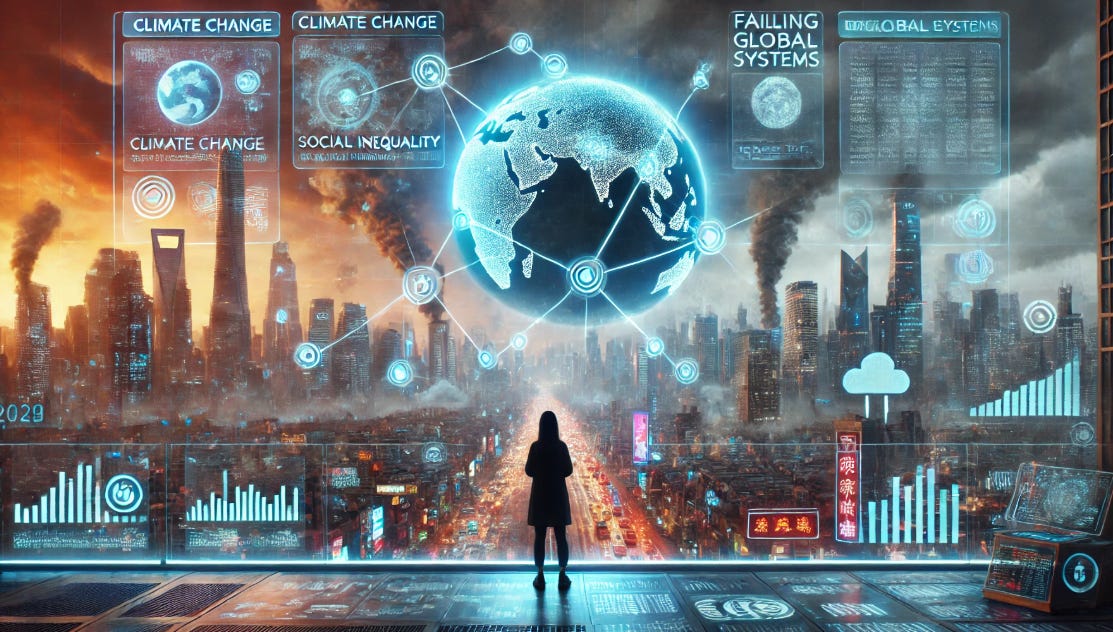2035: When Universal Patterns Changed Everything
Maya stood at the window of the Pattern Recognition Center, watching the holographic displays showcase the interconnected patterns flowing between different systems - ecological, social, and technological. As Chief Pattern Officer of the world's first pattern-driven innovation hub, she reflected on the journey that had led humanity to this breakthrough in problem-solving.
The Great Complexity Crisis of 2028
It had started during the Complexity Crisis of 2028. Traditional approaches to global challenges were failing. Climate change, social inequality, and technological disruption had created a perfect storm of interconnected problems that defied conventional solutions.
That's when Maya, then a data scientist with a passion for ancient wisdom, noticed something remarkable: the patterns in failing systems matched those described in ancient texts about natural cycles. She remembered reading about how Chinese medicine understood the body's meridians in ways that mysteriously aligned with modern network theory.
The Pattern Revolution Begins
Drawing from her diverse background - artificial intelligence, ecology, and traditional wisdom - Maya developed the Universal Pattern Framework. It started small, in a community project addressing water scarcity:
"The solution was always there," she would later write. "The way water moves through natural systems holds the key to how resources should flow through human societies. Nature doesn't waste; it creates circular systems."
The breakthrough came when she mapped biological immune system responses to community resilience patterns:
1. Detection Systems
- Biological: Immune cell recognition
- Community: Early warning networks
- Technology: AI pattern detection
2. Response Mechanisms
- Biological: Targeted immune response
- Community: Resource mobilization
- Technology: Adaptive systems
3. Memory and Learning
- Biological: Antibody production
- Community: Knowledge sharing
- Technology: Machine learning
The Birth of Pattern-Driven Enterprises
By 2030, Maya's approach had spawned a new breed of organization: the Pattern-Driven Enterprise (PDE). These companies operated on three core principles:
1. Universal Pattern Recognition
- Identifying core patterns across domains
- Mapping successful solutions to new contexts
- Building pattern libraries for innovation
2. Resource Flow Optimization
- Understanding natural resource cycles
- Implementing circular economy principles
- Creating regenerative business models
3. Adaptive System Design
- Building resilient organizations
- Developing responsive strategies
- Fostering evolutionary innovation
The Transformation
The impact was profound. A furniture company applied forest ecosystem patterns to supply chain design, creating the first truly regenerative production system. A financial services firm used river delta patterns to redesign money flow in underserved communities, revolutionizing microfinance.
But the real breakthrough came in 2033, when Maya's team cracked what they called the "Pattern Code" - a universal framework for mapping successful patterns from one domain to another. This led to the establishment of the Pattern Recognition Center, where leaders from around the world came to learn the art of pattern-driven innovation.
The New Generation of Impact Leaders
By 2035, a new generation of leaders had emerged. They weren't just entrepreneurs or executives; they were polymath "Pattern Navigators" who could:
- Read patterns across natural and human systems
- Transfer successful solutions between seemingly unrelated domains
- Create innovations that worked with, rather than against, natural patterns
Present Day at the Pattern Recognition Center
As Maya watched the new cohort of Pattern Navigators training in the center's main hall, she saw them working with the latest innovation: a quantum pattern recognition system that could identify and map patterns across dimensions of space, time, and scale.
A young innovator approached her, eyes bright with excitement. "We've just mapped the pattern of forest recovery after fire to post-conflict community rebuilding," she said. "The similarities are incredible - and the solutions that emerged..."
Maya smiled. This was why she had created the Center. Every day, these pattern seekers were discovering new ways to solve humanity's greatest challenges by understanding and applying nature's time-tested patterns.
The Future Beckons
As the sun set over the Center, Maya reflected on the journey ahead. The Pattern Recognition Revolution was just beginning. With each new pattern discovered and applied, humanity moved closer to creating a world that worked in harmony with natural systems.
The next generation of impact entrepreneurs would not just be building businesses; they would be pattern seekers, understanding and applying the universal principles that govern all successful systems.
Epilogue: A Message to Future Pattern Seekers
For those reading this in 2025, Maya's journey might seem like science fiction. But the foundations of pattern-driven innovation are already here:
- In the way biomimicry informs sustainable design
- In how network theory reveals social system dynamics
- In the patterns of successful innovation across history
The future belongs to those who can see, understand, and apply these universal patterns. The question is not whether pattern-driven innovation will transform our world, but who will lead this transformation.
Will you be among the pattern seekers?
_"In patterns, we find not just solutions, but the very grammar of innovation itself."_
- Maya Chen, Founder of the Pattern Recognition Center, 2035



For those who asked for more examples - check this out https://intertwingled.org/natural-information-architecture/